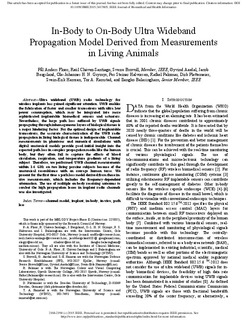| dc.contributor.author | Floor, Pål Anders | |
| dc.contributor.author | Chavez-Santiago, Raul | |
| dc.contributor.author | Brovoll, Sverre | |
| dc.contributor.author | Aardal, Øyvind | |
| dc.contributor.author | Bergsland, Jacob | |
| dc.contributor.author | Grymyr, Ole-Johannes | |
| dc.contributor.author | Halvorsen, Per Steinar | |
| dc.contributor.author | Palomar, Rafael | |
| dc.contributor.author | Plettemeier, Dirk | |
| dc.contributor.author | Hamran, Svein-Erik | |
| dc.contributor.author | Ramstad, Tor Audun | |
| dc.contributor.author | Balasingham, Ilangko | |
| dc.date.accessioned | 2015-05-06T08:47:10Z | |
| dc.date.accessioned | 2015-05-21T09:36:31Z | |
| dc.date.available | 2015-05-06T08:47:10Z | |
| dc.date.available | 2015-05-21T09:36:31Z | |
| dc.date.issued | 2015 | |
| dc.identifier.citation | IEEE journal of biomedical and health informatics 19(3) 2015 | nb_NO |
| dc.identifier.issn | 2168-2208 | |
| dc.identifier.uri | http://hdl.handle.net/11250/283857 | |
| dc.description.abstract | Ultra wideband (UWB) radio technology for wireless implants has gained significant attention. UWB enables the fabrication of faster and smaller transceivers with ultra low power consumption, which may be integrated into more sophisticated implantable biomedical sensors and actuators. Nevertheless, the large path loss suffered by UWB signals propagating through inhomogeneous layers of biological tissues is a major hindering factor. For the optimal design of implantable transceivers, the accurate characterization of the UWB radio propagation in living biological tissues is indispensable. Channel measurements in phantoms and numerical simulations with digital anatomical models provide good initial insight into the expected path loss in complex propagation media like the human body, but they often fail to capture the effects of blood circulation, respiration, and temperature gradients of a living subject. Therefore, we performed UWB channel measurements within 1-6 GHz on two living porcine subjects because of the anatomical resemblance with an average human torso. We present for the first time a path loss model derived from these invivo measurements, which includes the frequency-dependent attenuation. The use of multiple on-body receiving antennas to combat the high propagation losses in implant radio channels was also investigated. | nb_NO |
| dc.language.iso | eng | nb_NO |
| dc.publisher | IEEE | nb_NO |
| dc.title | In-Body to On-Body Ultra WidebandPropagation Model Derived from Measurementsin Living Animals | nb_NO |
| dc.type | Journal article | nb_NO |
| dc.type | Peer reviewed | |
| dc.date.updated | 2015-05-06T08:47:10Z | |
| dc.source.volume | 19 | nb_NO |
| dc.source.journal | IEEE Journal of Biomedical and Health Informatics | nb_NO |
| dc.source.issue | 3 | nb_NO |
| dc.identifier.doi | 10.1109/JBHI.2015.2417805 | |
| dc.identifier.cristin | 1238739 | |
| dc.description.localcode | This is the authors accepted and refereed manuscript to the article. (c) 2015 IEEE. Personal use of this material is permitted. Permission from IEEE must be obtained for all other users, including reprinting/ republishing this material for advertising or promotional purposes, creating new collective works for resale or redistribution to servers or lists, or reuse of any copyrighted components of this work in other works. | nb_NO |
